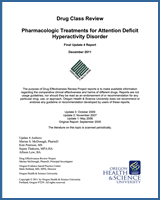NCBI Bookshelf. A service of the National Library of Medicine, National Institutes of Health.
This publication is provided for historical reference only and the information may be out of date.
Structured Abstract
Purpose:
Attention deficit hyperactivity disorder (ADHD) affects children and adults and is treated with both pharmacologic and nonpharmacologic interventions. Multiple drugs are used to treat ADHD. This review evaluates the evidence on how these drugs compare to each other in benefits and harms.
Data Sources:
To identify published studies, we searched MEDLINE, Cochrane Central Register of Controlled Trials, Cochrane Database of Systematic Reviews, Database of Abstracts of Reviews of Effects, and reference lists of included studies. We also searched the US Food and Drug Administration Center for Drug Evaluation and Research website for additional unpublished data and requested information from pharmaceutical manufacturers.
Review Methods:
Study selection, data abstraction, validity assessment, grading the strength of the evidence, and data synthesis were all carried out according to our standard review methods.
Results and Conclusions:
Evidence on the comparative effectiveness of drugs to treat ADHD was insufficient. Evidence on the comparative efficacy in children and adolescents was moderate to low strength and indicated very few differences among the drugs in improving symptoms or in adverse event rates. Sustained-release formulations of stimulants showed benefit over comparators at specific times of day depending on the pharmacokinetics of the specific formulation, but overall differences were not found. Atomoxetine (a nonstimulant) was not found superior to some extended-release stimulant products. Atomoxetine resulted in higher rates of vomiting and somnolence, similar rates of nausea and anorexia, and lower rates of insomnia than stimulants. Extended-release formulations of other nonstimulant drugs (clonidine, guanfacine) have no comparative evidence to date. Immediate-release clonidine was similar to immediate-release methylphenidate.
Comparative evidence in adults provided low-strength evidence of no significant differences in efficacy between switching to methylphenidate OROS compared with continuing with immediate-release methylphenidate or between immediate-release guanfacine or modafinil compared with immediate-release dextroamphetamine. Low-strength evidence found no significant differences between immediate-release guanfacine or modafinil compared with immediate-release dextroamphetamine.
Evidence on the risk of serious harms was primarily indirect, and indicated atomoxetine has increased risk of suicidal behavior compared with placebo. Differences in risk for sudden death was unclear, cardiac adverse events were not different between stimulants, and cerebrovascular adverse events in adults did not differ between stimulants and atomoxetine. Dextroamphetamine immediate-release caused more inhibition of growth than other stimulants, but the difference was influenced by dose and resolved after 2 years of treatment. Atomoxetine caused similar inhibition of weight gain that lasted up to 5 years. Evidence on abuse, misuse, and diversion was limited, but indicated that stimulant use during childhood is not associated with increased risk of substance use later. Misuse and diversion rates varied by age and were highest among college students, and rates of diversion were highest with amphetamine-based products but similar among methylphenidate products. Evidence of effects in important subgroups of patients with ADHD (e.g. comorbid anxiety) was not comparative.
Update 3: October 2009
Update 2: November 2007
Update 1: May 2006
Original Report: September 2005
The medical literature relating to this topic is scanned periodically. (See http://www.ohsu.edu/xd/research/centers-institutes/evidence-based-policy-center/derp/documents/methods.cfm for description of scanning process). Prior versions of this report can be accessed at the DERP website.
Drug Effectiveness Review Project, Marian McDonagh, PharmD, Principal Investigator
Oregon Evidence-based Practice Center, Mark Helfand, MD, MPH, DirectorOregon Health & Science University
Acknowledgments: We thank Leah Williams, our publications editor, for putting this report into its present form for you to read.
Suggested citation:
McDonagh MS, Peterson K, Thakurta S, Low A. Drug class review: Pharmacologic treatments for attention deficit hyperactivity disorder. Update 4 final report. Prepared by the Oregon Evidence-based Practice Center for the Drug Effectiveness Review Project. Oregon Health & Science University. Portland, OR. 2011. Available at: http://derp.ohsu.edu/about/final-document-display.cfm
The purpose of Drug Effectiveness Review Project reports is to make available information regarding the comparative clinical effectiveness and harms of different drugs. Reports are not usage guidelines, nor should they be read as an endorsement of or recommendation for any particular drug, use, or approach. Oregon Health & Science University does not recommend or endorse any guideline or recommendation developed by users of these reports.
- Review Atomoxetine: a review of its use in attention-deficit hyperactivity disorder in children and adolescents.[Paediatr Drugs. 2009]Review Atomoxetine: a review of its use in attention-deficit hyperactivity disorder in children and adolescents.Garnock-Jones KP, Keating GM. Paediatr Drugs. 2009; 11(3):203-26.
- Attention-deficit hyperactivity disorder: recent advances in paediatric pharmacotherapy.[Drugs. 2010]Attention-deficit hyperactivity disorder: recent advances in paediatric pharmacotherapy.May DE, Kratochvil CJ. Drugs. 2010; 70(1):15-40.
- Review Drug Class Review: Atypical Antipsychotic Drugs: Final Update 3 Report[ 2010]Review Drug Class Review: Atypical Antipsychotic Drugs: Final Update 3 ReportMcDonagh M, Peterson K, Carson S, Fu R, Thakurta S. 2010 Jul
- Amphetamines for attention deficit hyperactivity disorder (ADHD) in adults.[Cochrane Database Syst Rev. 2018]Amphetamines for attention deficit hyperactivity disorder (ADHD) in adults.Castells X, Blanco-Silvente L, Cunill R. Cochrane Database Syst Rev. 2018 Aug 9; 8(8):CD007813. Epub 2018 Aug 9.
- The pharmacological and non-pharmacological treatment of attention deficit hyperactivity disorder in children and adolescents: A systematic review with network meta-analyses of randomised trials.[PLoS One. 2017]The pharmacological and non-pharmacological treatment of attention deficit hyperactivity disorder in children and adolescents: A systematic review with network meta-analyses of randomised trials.Catalá-López F, Hutton B, Núñez-Beltrán A, Page MJ, Ridao M, Macías Saint-Gerons D, Catalá MA, Tabarés-Seisdedos R, Moher D. PLoS One. 2017; 12(7):e0180355. Epub 2017 Jul 12.
- Drug Class Review: Pharmacologic Treatments for Attention Deficit Hyperactivity ...Drug Class Review: Pharmacologic Treatments for Attention Deficit Hyperactivity Disorder
Your browsing activity is empty.
Activity recording is turned off.
See more...
